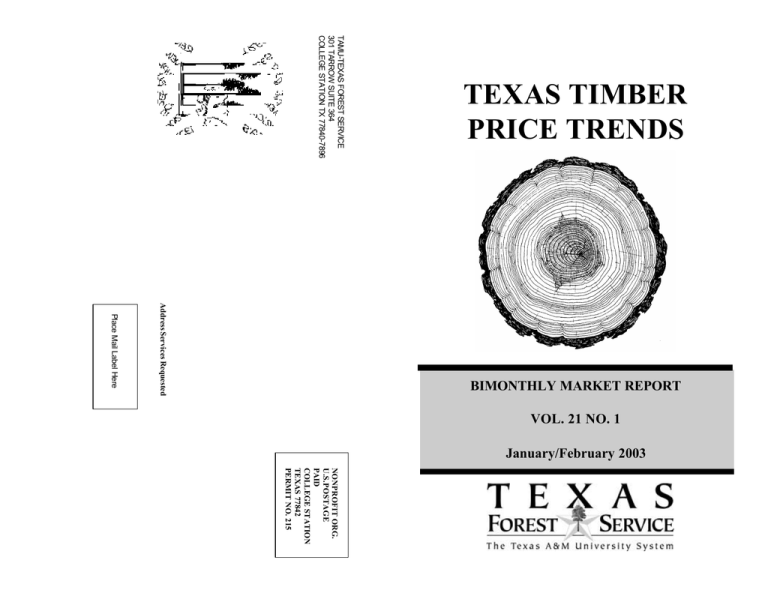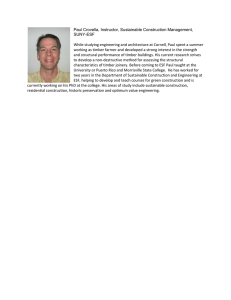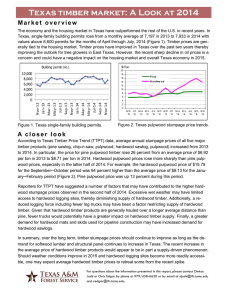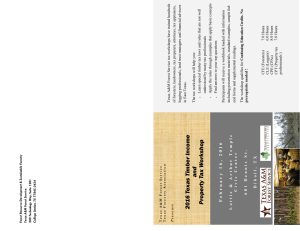TEXAS TIMBER PRICE TRENDS BIMONTHLY MARKET REPORT VOL. 21 NO. 1
advertisement

TAMU-TEXAS FOREST SERVICE 301 TARROW SUITE 364 COLLEGE STATION TX 77840-7896 TEXAS TIMBER PRICE TRENDS Place Mail Label Here Address Services Requested BIMONTHLY MARKET REPORT VOL. 21 NO. 1 January/February 2003 NONPROFIT ORG. U.S.POSTAGE PAID COLLEGE STATION TEXAS 77842 PERMIT NO. 215 TEXAS TIMBER PRICE TRENDS WHAT IS THE PURPOSE OF THIS REPORT? Texas Timber Price Trends is a bi-monthly publication reporting average prices paid for standing timber, commonly called the “stumpage price,” for the two months listed in the report. Its purpose is to provide timely information concerning timber market conditions in order to improve decision making and foster fair transactions that benefit both buyer and seller and encourage conservation of the timber resource. Market information is particularly important to nonindustrial private landowners who are only infrequent participants in this complex market. WHERE DOES THE DATA COME FROM? Average stumpage prices published in this report are calculated from actual timber sales as reported by as many as 60 cooperators active in the East Texas timber market. Reporters include consulting foresters, large nonindustrial landowners, financial institutions, forest products companies, and state and federal agencies. Research has shown that a diversity of reporters tends to reduce bias and improve the reliability of the price estimates. VOLUME CONVERSION FACTORS A specific conversion factor for each sale reported by the reporters is used for price calculations when available; otherwise, the following average conversion factors are used: Sawlogs MBF-International-1/4" X 0.74 = MBF-Doyle MBF-Scribner X 0.78 = MBF-Doyle MBF-USFS Scribner X 0.814 = MBF-Doyle Pine - 8 Tons = 1 MBF-Doyle Hardwood - 9 Tons = 1 MBF-Doyle Pine Chip-N-Saw: 1 Cord = 2.625 tons Pulpwood Pine, Northeast TX - 2.5 Tons = 1 Cord Pine, Southeast TX - 2.625 Tons = 1 Cord Hardwood, 2.8 Tons = 1 Cord Pine - 81 Cubic Feet = 1 Cord Hardwood - 80 Cubic Feet = 1 Cord SUBSCRIPTION INFORMATION HOW ARE AVERAGE PRICES CALCULATED? The calculation of average prices weighs each sale by the volume sold. This is done to filter out the effect that the size of the sale has on the price paid, thus providing a more consistent and meaningful average. The result is that the average price reported is the average price paid per unit of volume, NOT per the average timber sale. The price per ton for each product category is calculated from the price per volume unit using the conversion factors listed on page 8 of the report. Readers should note that volume to weight conversions vary depending on the average diameter of the logs in the sale. Because we don’t have information on average diameters for each sale reported, the per ton prices presented are based on an average conversion factor and not information from the specific sales reports. HOW CAN I USE THIS REPORT? This report is intended to serve only as a guide to general price levels. Individuals interested in selling timber can use this report to monitor market trends and get a general idea of what their timber is worth. However, it should not be used to judge the fair market value of a specific timber sale. The price paid for a specific stand of timber will vary considerably due to such factors as: size, species, and quality of timber; total volume and volume per acre; logging conditions; distance to the mill; end product of manufacture; and current demand and local competition for timber. Additionally, timber markets often change rapidly and therefore past prices are not necessarily a reflection of current market prices. We strongly recommend the use of a competitive bidding process as the ultimate determinant of market price for any specific tract of timber. 1 Texas Timber Price Trends is a publication of the Texas Forest Service and is available at $2 per copy from your local TFS office, or through an annual mail subscription of $10 per year. To subscribe, please send your request and check or money order (payable to "Texas Forest Service") to: Attn: Texas Timber Price Trends Texas Forest Service 301 Tarrow Suite 364 College Station, TX 77840-7896 This publication is also available free of charge on Texas Forest Service website: http://txforestservice.tamu.edu/forest_management/ texas_timber_price_trends/index.html) WANT TO BE A REPORTER? If you are active in the East Texas timber market, please consider becoming a cooperating price reporter. You’ll receive report forms bi-monthly with a self-return envelope. In addition, you’ll receive a complimentary subscription to the report in exchange for your price information. To sign up, contact the Texas Forest Service at the above address. The Texas Forest Service is an Equal Opportunity Employer 8 COMMENTS Texas Timber Price Trends Market Regions The January/February 2003 report is the first issue that included gatewood sales in the stumpage price statistics. Much timber was sold to the mills with its stumpage price information not available for statistics publishing. Timber prices paid by the mills was collected to enable an estimation of the stumpage price paid to the landowner (the difference is the "cut-n-haul cost, other expenses and profits if any".) We appreciate every reporter for their valuable contributions to this publication and providing estimates on "cut-n-haul cost, other expenses and any profits" data. Red River Titus Morris Franklin Bowie Cass Camp Northeast TX Region I Wood Pine timber product prices declined while hardwood product prices were steady. Pine sawlog price averaged $42/ton ($316/MBF) in East Texas. Pine pulpwood price was $6/ton ($16/cord). Pine chip-n-saw price was $15/ton ($38/cord). The average price of hardwood sawlog was $13/ton ($128/MBF) and hardwood pulpwood price averaged 5/ton ($14/cord). Marion Upshur Harrison Van Zandt Gregg Smith Henderson Panola Rusk Anderson Timberland Sales Cherokee Shelby Leon Houston San Augustine Nacogdoches Angelina Sabine Grimes Polk Tyler San Jacinto Southeast TX Hardin Montgomery Region II Liberty Waller Jasper Walker Newton Trinity Madison Harris 7 Chambers Orange Jefferson Ownership of the vast East Texas timberland is moving from the traditional forest product companies to investment groups—a significant structural change in East Texas forest industry in recent history. A staggering amount of timberland, about 1.5 million acres, in East Texas was on sale by the major forest companies (mainly from IP and LP). That is nearly 45% of the total industrial holdings in East Texas. Major investment organizations in East Texas include Molpus, Forest Investment Associate, the Forestland Group, UBS, Wachovia, Hancock, Prudential Timber, and Plum Creek. Timberland was perceived by some investors as uniquely attractive investment vehicle due to several factors. First, when the general security market is down, performance of timberland tends to be up, thus timberland has strong asset diversification characteristics. Second, historically timberland has generated return comparable or better than major stock indexes (for example S&P 500) with lower risk (forest system.com). This factor prompted interests in timberland investment and stimulated strong demand for it recently. 2 Timberland Sales (Cont'd): Third, Timberland investment return includes both income stream and land appreciation components. Also, timberland investment is relatively inflation efficient since its land value and sale income tend to go up with inflation. The reasons for forest product companies to sell timberland: Timberland sales represent a major strategy change for the forest product companies. These industrial landowners have increasingly begun to view their forests as financial assets, rather than simply as raw material supply base. By monetizing the land as an investment, timberland sales enhances asset values. Furthermore, companies shifted their focus away from both owning large amount of land and product manufacturing. Major focus is placed on core product manufacturing areas to improve competition position. These land sales also reflected the fact that large forest product companies have been under tremendous pressure from the poor financial market performance. The sluggish market with the general economic slowdown have cut the earning and profits significantly. Coupled with the merger & acquisition in the industry in the recent past, high levels of debt was accumulated by the consolidators. Both IP and LP plan to reduce debt from the sale proceeds of their forestland. PINE SAWTIMBER High Low Statewide Weighted Average Price $/MBF-Doyle TEXAS ANNUAL STATEWIDE AVERAGE STUMPAGE PRICES Year 1984 1985 1986 1987 1988 1989 1990 1991 1992 1993 1994 1995 1996 1997 1998 1999 2000 2001 2002 2003.1 Sawlog $/MBF-Doyle 170.53 129.87 127.45 142.59 152.31 156.32 163.34 189.33 252.26 283.80 358.03 438.36 395.46 441.75 414.51 382.86 376.57 325.14 334.86 315.52 Pine Chip-N-Saw $/Cord 30.85 28.35 23.68 22.53 24.88 26.25 30.12 29.71 39.39 39.46 47.81 62.96 59.18 73.39 76.40 68.44 57.69 42.06 41.92 37.88 Pulpwood $/Cord 23.48 18.46 14.53 15.28 16.33 18.45 22.17 22.59 27.98 26.89 22.75 27.26 25.25 28.61 37.01 28.95 19.20 12.94 12.33 16.21 600 500 400 300 200 100 0 J/F M/A M/J J/A S/O N/D J/F M/A M/J J/A S/O N/D J/F '01 '01 '01 '01 '01 '01 '02 '02 '02 '02 '02 '02 '03 3 6 Hardwood Sawlog Pulpwood $/MBF-Doyle $/Cord 54.61 4.03 54.79 5.13 46.16 4.18 55.46 6.78 64.93 6.59 69.48 9.27 62.20 6.03 53.83 9.09 67.04 10.10 80.67 12.76 93.77 15.57 105.17 28.65 88.28 10.78 132.20 25.20 138.75 14.41 139.44 12.24 120.88 7.97 120.32 15.11 156.97 15.67 127.77 14.42 PINE CHIP-N-SAW HARDWOOD SAWTIMBER $/MBF-Doyle High Low Statewide Weihghted Average Price $/Cord High Low Statewide Weighted Average Price 100 350 90 300 80 70 250 60 200 50 N/A 40 150 30 100 20 50 10 0 0 J/F M/A M/J J/A S/O N/D J/F M/A M/J J/A S/O N/D J/F '01 '01 '01 '01 '01 '01 '02 '02 '02 '02 '02 '02 '03 J/F M/A M/J J/A S/O N/D J/F M/A M/J J/A S/O N/D J/F '01 '01 '01 '01 '01 '01 '02 '02 '02 '02 '02 '02 '03 PINE PULPWOOD HARDWOOD PULPWOOD $/Cord High Low Statewide Weighted Average Price High Low Statewide Weighted Average Price $/Cord 40 45 40 35 35 30 30 25 25 20 20 15 15 10 10 5 5 0 0 J/F M/A M/J J/A S/O N/D J/F M/A M/J J/A S/O N/D J/F '01 '01 '01 '01 '01 '01 '02 '02 '02 '02 '02 '02 '03 5 J/F M/A M/J J/A S/O N/D J/F M/A M/J J/A S/O N/D J/F '01 '01 '01 '01 '01 '01 '02 '02 '02 '02 '02 '02 '03 4 Product/Region PINE Average Price # of Sales Reported STUMPAGE PRICE TRENDS IN TEXAS January/February 2003 Average Price Same Period A Year Ago 47 32 79 2 Average Price Last Period $/MBF 317.40 362.22 344.97 ** $/Ton 45.47 45.96 45.67 40.43 $/Ton 39.67 45.28 43.12 ** $/MBF 312.31 318.47 315.52 ** $/MBF 345.64 328.42 338.36 323.47 $/Ton 41.43 42.99 42.23 ** 74 22 96 2 Sawlogs Northeast TX Southeast TX Statewide* USFS $/Cord 15.27 9.37 13.12 ** $/Cord $/Ton 6.11 3.57 5.15 ** 17 20 37 ** $/Ton $/Cord 18.19 10.29 16.03 11.52 $/Cord 44.28 38.46 38.73 ** 15 1 16 ** $Ton 7.21 3.97 6.30 4.39 $/Ton 16.87 14.65 14.76 ** $/MBF 122.60 146.12 126.65 ** 20 2 22 1 ** $/Cord 50.78 ** 49.96 ** $/Ton 13.62 16.24 14.07 ** $/Cord 12.75 11.53 12.56 ** 17.50 14.26 16.21 $/Cord $/Ton 20.14 ** 17.86 ** $/MBF ** ** 126.79 ** $/Ton 4.55 4.12 4.49 ** ** $/Ton ** 41.69 37.74 37.88 $/Ton ** ** 15.05 ** $/Cord 14.24 17.58 15.30 ** 6.41 5.34 5.98 ** $/MBF 16.21 14.79 14.84 $/Ton ** 127.64 ** 127.77 $/Cord ** $/Ton ** 15.94 ** 14.42 13.72 ** 13.74 ** 5.66 ** 5.22 $/Ton 4.94 6.34 5.38 ** Pulpwood Northeast TX Southeast TX Statewide* USFS Chip-N-Saw Northeast TX Southeast TX Statewide* USFS HARDWOOD Sawlogs Northeast TX Southeast TX Statewide* USFS Pulpwood Northeast TX Southeast TX Statewide* USFS 4-Apr-03 Volume 21, No. 1 Ton ** 18,099 19,673 37,772 MBF Total Volume ** Cord 137,875 145,706 283,582 Ton ** 121,820 80,983 202,804 Cord ** Ton ** 1,625 42,606 44,232 318,923 217,981 536,904 ** MBF 4,182 113,155 117,337 Ton ** 328 6 334 Cord ** Ton ** 2,772 10,593 13,365 3,052 54 3,106 ** 7,809 29,131 36,939 1. Starting from this issue, stumpage price statistics included gatewood sales. 2. Price is calculated from a specific conversion factor reported for each sale if available; otherwise, the average conversion factors listed on page 8 are used. MBF = Thousand Borad Feet. The DOYLE LOG SCALE is used for board foot measurements. *Statewide data excludes U.S. Forest Service sales. **Insufficient sales to report price statistics (less than three reported sales). PINE CHIP-N-SAW HARDWOOD SAWTIMBER $/MBF-Doyle High Low Statewide Weihghted Average Price $/Cord High Low Statewide Weighted Average Price 100 350 90 300 80 70 250 60 200 50 N/A 40 150 30 100 20 50 10 0 0 J/F M/A M/J J/A S/O N/D J/F M/A M/J J/A S/O N/D J/F '01 '01 '01 '01 '01 '01 '02 '02 '02 '02 '02 '02 '03 J/F M/A M/J J/A S/O N/D J/F M/A M/J J/A S/O N/D J/F '01 '01 '01 '01 '01 '01 '02 '02 '02 '02 '02 '02 '03 PINE PULPWOOD HARDWOOD PULPWOOD $/Cord High Low Statewide Weighted Average Price High Low Statewide Weighted Average Price $/Cord 40 45 40 35 35 30 30 25 25 20 20 15 15 10 10 5 5 0 0 J/F M/A M/J J/A S/O N/D J/F M/A M/J J/A S/O N/D J/F '01 '01 '01 '01 '01 '01 '02 '02 '02 '02 '02 '02 '03 5 J/F M/A M/J J/A S/O N/D J/F M/A M/J J/A S/O N/D J/F '01 '01 '01 '01 '01 '01 '02 '02 '02 '02 '02 '02 '03 4 Timberland Sales (Cont'd): Third, Timberland investment return includes both income stream and land appreciation components. Also, timberland investment is relatively inflation efficient since its land value and sale income tend to go up with inflation. The reasons for forest product companies to sell timberland: Timberland sales represent a major strategy change for the forest product companies. These industrial landowners have increasingly begun to view their forests as financial assets, rather than simply as raw material supply base. By monetizing the land as an investment, timberland sales enhances asset values. Furthermore, companies shifted their focus away from both owning large amount of land and product manufacturing. Major focus is placed on core product manufacturing areas to improve competition position. These land sales also reflected the fact that large forest product companies have been under tremendous pressure from the poor financial market performance. The sluggish market with the general economic slowdown have cut the earning and profits significantly. Coupled with the merger & acquisition in the industry in the recent past, high levels of debt was accumulated by the consolidators. Both IP and LP plan to reduce debt from the sale proceeds of their forestland. PINE SAWTIMBER High Low Statewide Weighted Average Price $/MBF-Doyle TEXAS ANNUAL STATEWIDE AVERAGE STUMPAGE PRICES Year 1984 1985 1986 1987 1988 1989 1990 1991 1992 1993 1994 1995 1996 1997 1998 1999 2000 2001 2002 2003.1 Sawlog $/MBF-Doyle 170.53 129.87 127.45 142.59 152.31 156.32 163.34 189.33 252.26 283.80 358.03 438.36 395.46 441.75 414.51 382.86 376.57 325.14 334.86 315.52 Pine Chip-N-Saw $/Cord 30.85 28.35 23.68 22.53 24.88 26.25 30.12 29.71 39.39 39.46 47.81 62.96 59.18 73.39 76.40 68.44 57.69 42.06 41.92 37.88 Pulpwood $/Cord 23.48 18.46 14.53 15.28 16.33 18.45 22.17 22.59 27.98 26.89 22.75 27.26 25.25 28.61 37.01 28.95 19.20 12.94 12.33 16.21 600 500 400 300 200 100 0 J/F M/A M/J J/A S/O N/D J/F M/A M/J J/A S/O N/D J/F '01 '01 '01 '01 '01 '01 '02 '02 '02 '02 '02 '02 '03 3 6 Hardwood Sawlog Pulpwood $/MBF-Doyle $/Cord 54.61 4.03 54.79 5.13 46.16 4.18 55.46 6.78 64.93 6.59 69.48 9.27 62.20 6.03 53.83 9.09 67.04 10.10 80.67 12.76 93.77 15.57 105.17 28.65 88.28 10.78 132.20 25.20 138.75 14.41 139.44 12.24 120.88 7.97 120.32 15.11 156.97 15.67 127.77 14.42 COMMENTS Texas Timber Price Trends Market Regions The January/February 2003 report is the first issue that included gatewood sales in the stumpage price statistics. Much timber was sold to the mills with its stumpage price information not available for statistics publishing. Timber prices paid by the mills was collected to enable an estimation of the stumpage price paid to the landowner (the difference is the "cut-n-haul cost, other expenses and profits if any".) We appreciate every reporter for their valuable contributions to this publication and providing estimates on "cut-n-haul cost, other expenses and any profits" data. Red River Titus Morris Franklin Bowie Cass Camp Northeast TX Region I Wood Pine timber product prices declined while hardwood product prices were steady. Pine sawlog price averaged $42/ton ($316/MBF) in East Texas. Pine pulpwood price was $6/ton ($16/cord). Pine chip-n-saw price was $15/ton ($38/cord). The average price of hardwood sawlog was $13/ton ($128/MBF) and hardwood pulpwood price averaged 5/ton ($14/cord). Marion Upshur Harrison Van Zandt Gregg Smith Henderson Panola Rusk Anderson Timberland Sales Cherokee Shelby Leon Houston San Augustine Nacogdoches Angelina Sabine Grimes Polk Tyler San Jacinto Southeast TX Hardin Montgomery Region II Liberty Waller Jasper Walker Newton Trinity Madison Harris 7 Chambers Orange Jefferson Ownership of the vast East Texas timberland is moving from the traditional forest product companies to investment groups—a significant structural change in East Texas forest industry in recent history. A staggering amount of timberland, about 1.5 million acres, in East Texas was on sale by the major forest companies (mainly from IP and LP). That is nearly 45% of the total industrial holdings in East Texas. Major investment organizations in East Texas include Molpus, Forest Investment Associate, the Forestland Group, UBS, Wachovia, Hancock, Prudential Timber, and Plum Creek. Timberland was perceived by some investors as uniquely attractive investment vehicle due to several factors. First, when the general security market is down, performance of timberland tends to be up, thus timberland has strong asset diversification characteristics. Second, historically timberland has generated return comparable or better than major stock indexes (for example S&P 500) with lower risk (forest system.com). This factor prompted interests in timberland investment and stimulated strong demand for it recently. 2 TEXAS TIMBER PRICE TRENDS WHAT IS THE PURPOSE OF THIS REPORT? Texas Timber Price Trends is a bi-monthly publication reporting average prices paid for standing timber, commonly called the “stumpage price,” for the two months listed in the report. Its purpose is to provide timely information concerning timber market conditions in order to improve decision making and foster fair transactions that benefit both buyer and seller and encourage conservation of the timber resource. Market information is particularly important to nonindustrial private landowners who are only infrequent participants in this complex market. WHERE DOES THE DATA COME FROM? Average stumpage prices published in this report are calculated from actual timber sales as reported by as many as 60 cooperators active in the East Texas timber market. Reporters include consulting foresters, large nonindustrial landowners, financial institutions, forest products companies, and state and federal agencies. Research has shown that a diversity of reporters tends to reduce bias and improve the reliability of the price estimates. VOLUME CONVERSION FACTORS A specific conversion factor for each sale reported by the reporters is used for price calculations when available; otherwise, the following average conversion factors are used: Sawlogs MBF-International-1/4" X 0.74 = MBF-Doyle MBF-Scribner X 0.78 = MBF-Doyle MBF-USFS Scribner X 0.814 = MBF-Doyle Pine - 8 Tons = 1 MBF-Doyle Hardwood - 9 Tons = 1 MBF-Doyle Pine Chip-N-Saw: 1 Cord = 2.625 tons Pulpwood Pine, Northeast TX - 2.5 Tons = 1 Cord Pine, Southeast TX - 2.625 Tons = 1 Cord Hardwood, 2.8 Tons = 1 Cord Pine - 81 Cubic Feet = 1 Cord Hardwood - 80 Cubic Feet = 1 Cord SUBSCRIPTION INFORMATION HOW ARE AVERAGE PRICES CALCULATED? The calculation of average prices weighs each sale by the volume sold. This is done to filter out the effect that the size of the sale has on the price paid, thus providing a more consistent and meaningful average. The result is that the average price reported is the average price paid per unit of volume, NOT per the average timber sale. The price per ton for each product category is calculated from the price per volume unit using the conversion factors listed on page 8 of the report. Readers should note that volume to weight conversions vary depending on the average diameter of the logs in the sale. Because we don’t have information on average diameters for each sale reported, the per ton prices presented are based on an average conversion factor and not information from the specific sales reports. HOW CAN I USE THIS REPORT? This report is intended to serve only as a guide to general price levels. Individuals interested in selling timber can use this report to monitor market trends and get a general idea of what their timber is worth. However, it should not be used to judge the fair market value of a specific timber sale. The price paid for a specific stand of timber will vary considerably due to such factors as: size, species, and quality of timber; total volume and volume per acre; logging conditions; distance to the mill; end product of manufacture; and current demand and local competition for timber. Additionally, timber markets often change rapidly and therefore past prices are not necessarily a reflection of current market prices. We strongly recommend the use of a competitive bidding process as the ultimate determinant of market price for any specific tract of timber. 1 Texas Timber Price Trends is a publication of the Texas Forest Service and is available at $2 per copy from your local TFS office, or through an annual mail subscription of $10 per year. To subscribe, please send your request and check or money order (payable to "Texas Forest Service") to: Attn: Texas Timber Price Trends Texas Forest Service 301 Tarrow Suite 364 College Station, TX 77840-7896 This publication is also available free of charge on Texas Forest Service website: http://txforestservice.tamu.edu/forest_management/ texas_timber_price_trends/index.html) WANT TO BE A REPORTER? If you are active in the East Texas timber market, please consider becoming a cooperating price reporter. You’ll receive report forms bi-monthly with a self-return envelope. In addition, you’ll receive a complimentary subscription to the report in exchange for your price information. To sign up, contact the Texas Forest Service at the above address. The Texas Forest Service is an Equal Opportunity Employer 8



